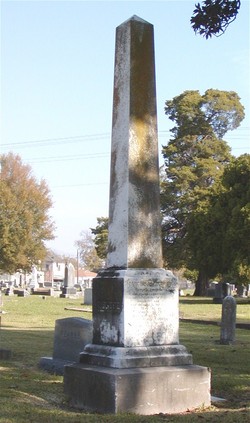Cluff was born in Alabama
Cluff and Capt. Lemuel Dawson McLain, a local merchant, had an argument about money. Lemuel owed Cluff and Cluff was planning to move his family to Florida
"I met McCullough this evening and he asked me where McClain was. I told him he was gone to Black Bayou. He said he wanted to see him. I told him we would walk up the street and perhaps we would meet him. We went as far as Dr. Sholars’ and I turned back. When I saw him again I had seen McLain, and he asked for him again. I told him McLain said he would be back there in a few minutes. He said he would go up the street and look for him and walked off. After some little time I went up the street and met Mr. McCullough and he said he had been told McLain had come down the street and said McLain was a damn big head fool with his money and that he did not intend to fool with him much longer. We walked together as far as Mr. Kelley’s saloon; he went in; McLain saw me and came out to me and said he wanted to see me and we walked out on the crossing, about midway in the street, perhaps further, and were talking on business, when McCullough walked up and asked McLain if he was going to pay that money. McLain said he would, but was very busy then, but if he would meet him at the bank in the morning at 9 o’clock, he would pay him. McCullough walked off to the other side of the street and turned around and told McLain he would carry the order back to Mr. Mitchner. McLain repeated again that he would pay him in the morning at 9 o’clock if he would meet him at the bank. McCullough said he would take it back to Mr. Mitchner; McLain said; “Well carry it back to him then.” McCullough said to McLain: “You are acting the damn rascal with me,” and put his hand in his pocket and started back towards McLain; McLain drew his pistol; McCullough had then reached McLain, who shoved him off once or twice and slapped him once. I shoved him off once and still he pressed upon McLain and shoved him back to the ditch. I thought McLain would shoot him and I got away; I saw him shoot and McCullough fall."
W.W. Farmer also testified. "At one o’clock to-day I went to the house of L.D. McLain on business. I found McLain absent. I left the house at 15 minutes past 4 o’clock; as I walked off the gallery McCullough had reached the front gate, after having inquired for McLain at the front door. Having business with McCullough, I called him and he stopped and we walked together up Jackson street and up DeSiard to Mr. Dedman’s saloon. We had not quite finished our business, and he said he would call to see me the next morning; he had to see McLain and asked me if I knew where he could find him. I told him I did not know, but that I was sure he had come back, for Charley Crosley had come back with him, and he said he knew he was in town and was bound to hunt him up. He said he need not think because he could prance around on fine horses, he could put him off. Both parties being friends of mine, I made no reply. He walked into Dedman’s saloon and I walked to Breard’s front door and while standing receipting for a telegram, McCollough passed by and enquired of some one. If he had seen that high headed McLain. I did not observe the reply. I went to D.B. Gunby’s store to show him the telegram; leaving there with D.B. Trousdale, we reached the corner at Sanders’s store and stopped there talking. At about 5 o’clock I saw McLain and Mr. Dunn standing on the crossing in front of Keller’s saloon, about 8 feet from the western ditch. McLain had his back to me, Dunn facing me; McCullough was standing on the plank crossing with his back to the river, facing McLain and Dunn. My attention was attracted particularly to them from McCullough’s excited manner. I could not hear what either of the two men said; I was distant from them about 90 feet. McCullough suddenly walked in an excited manner from the crossing onto the side walk and suddenly stopped and the next moment he stepped across the ditch towards McLain, and had advanced two or three steps, when McLain drew a large bright pistol, he did not attempt to shoot McCullough at that time, but held it in his right hand and was gesticulating with his left. I could not hear what either one said. McCullough continued to advance until he reached McLain; he attempted to catch hold of McLain who pushed him off. This scuffling began on the north side of the crossing and during its continuance on the south side, Mr. Green Dunn interfered between the parties and separated them. After he had separated them, Mr. McCullough was about 20 feet from the western ditch out in the street, McLain about 5 feet north west
Cluff lay dead in DeSiard Street. The shot had hit him above the right eye. A massive funeral was held and all that was mortal of Cluff was laid to rest in the Old City Cemetery







